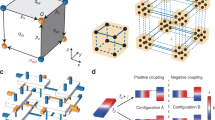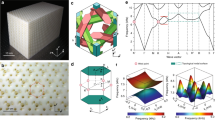Abstract
Unconventional chiral particles have recently been predicted to appear in certain three-dimensional crystal structures containing three- or more-fold linear band degeneracy points (BDPs)1,2,3,4. These BDPs carry topological charges, but are distinct from the standard twofold Weyl points or fourfold Dirac points, and cannot be described in terms of an emergent relativistic field theory1. Here we report on the experimental observation of a topological threefold BDP in a three-dimensional phononic crystal. Using direct acoustic field mapping, we demonstrate the existence of the threefold BDP in the bulk band structure, as well as doubled Fermi arcs of surface states consistent with a topological charge of 2. Another novel BDP, similar to a Dirac point but carrying non-zero topological charge, is connected to the threefold BDP via the doubled Fermi arcs. The Fermi arcs form double helicoids spanning a broad frequency range (relative bandwidth >25%). We show that the non-contractibility of these arcs gives rise to the phenomenon of topologically protected negative refraction of surface states on all surfaces of the sample. Our work paves the way to using these unconventional particles for exploring new emergent physical phenomena, and may find applications in symmetry-stabilized three-dimensional zero-index metamaterials.
This is a preview of subscription content, access via your institution
Access options
Access Nature and 54 other Nature Portfolio journals
Get Nature+, our best-value online-access subscription
$29.99 / 30 days
cancel any time
Subscribe to this journal
Receive 12 print issues and online access
$209.00 per year
only $17.42 per issue
Buy this article
- Purchase on Springer Link
- Instant access to full article PDF
Prices may be subject to local taxes which are calculated during checkout




Similar content being viewed by others
Data availability
The data that support the findings of this study are available from the corresponding author upon reasonable request.
References
Bradlyn, B. et al. Beyond Dirac and Weyl fermions: unconventional quasiparticles in conventional crystals. Science 353, aaf5037 (2016).
Zhang, T. et al. Double-Weyl phonons in transition-metal monosilicides. Phys. Rev. Lett. 120, 016401 (2018).
Chang, G. et al. Unconventional chiral Fermions and large topological Fermi arcs in RhSi. Phys. Rev. Lett. 119, 206401 (2017).
Tang, P., Zhou, Q. & Zhang, S.-C. Multiple types of topological fermions in transition metal silicides. Phys. Rev. Lett. 119, 206402 (2017).
Novoselov, K. S. et al. Two-dimensional gas of massless Dirac fermions in graphene. Nature 438, 197–200 (2005).
Wan, X., Turner, A. M., Vishwanath, A. & Savrasov, S. Y. Topological semimetal and Fermi-arc surface states in the electronic structure of pyrochlore iridates. Phys. Rev. B 83, 205101 (2011).
Xu, S.-Y. et al. Discovery of a Weyl fermion semimetal and topological Fermi arcs. Science 349, 613–617 (2015).
Lu, L. et al. Experimental observation of Weyl points. Science 349, 622–624 (2015).
Lv, B. et al. Experimental discovery of Weyl semimetal TaAs. Phys. Rev. X 5, 031013 (2015).
Xiao, M., Chen, W.-J., He, W.-Y. & Chan, C. T. Synthetic gauge flux and Weyl points in acoustic systems. Nat. Phys. 11, 920–924 (2015).
Noh, J. et al. Experimental observation of optical Weyl points and Fermi arc-like surface states. Nat. Phys. 13, 611–617 (2017).
Armitage, N., Mele, E. & Vishwanath, A. Weyl and Dirac semimetals in three-dimensional solids. Rev. Mod. Phys. 90, 015001 (2018).
Yang, B. et al. Ideal Weyl points and helicoid surface states in artificial photonic crystal structures. Science 359, 1013–1016 (2018).
Li, F., Huang, X., Lu, J., Ma, J. & Liu, Z. Weyl points and Fermi arcs in a chiral phononic crystal. Nat. Phys. 14, 30–34 (2018).
Kargarian, M., Randeria, M. & Lu, Y.-M. Are the surface Fermi arcs in Dirac semimetals topologically protected? Proc. Natl Acad. Sci. USA 113, 8648–8652 (2016).
Fang, C., Gilbert, M. J., Dai, X. & Bernevig, B. A. Multi-Weyl topological semimetals stabilized by point group symmetry. Phys. Rev. Lett. 108, 266802 (2012).
Huang, S.-M. et al. New type of Weyl semimetal with quadratic double Weyl fermions. Proc. Natl Acad. Sci. USA 113, 1180–1185 (2016).
Chen, W. J., Xiao, M. & Chan, C. T. Photonic crystals possessing multiple Weyl points and the experimental observation of robust surface states. Nat. Commun. 7, 13038 (2016).
Manes, J. L. Existence of bulk chiral fermions and crystal symmetry. Phys. Rev. B 85, 155118 (2012).
Lv, B. et al. Observation of three-component fermions in the topological semimetal molybdenum phosphide. Nature 546, 627–631 (2017).
Ma, J.-Z. et al. Three-component fermions with surface Fermi arcs in tungsten carbide. Nat. Phys. 14, 349–354 (2018).
Miao, H. et al. Observation of double Weyl phonons in parity-breaking FeSi. Phys. Rev. Lett. 121, 035302 (2018).
Yu, R., Qi, X. L., Bernevig, A., Fang, Z. & Dai, X. Equivalent expression of Z2 topological invariant for band insulators using the non-Abelian Berry connection. Phys. Rev. B 84, 075119 (2011).
Nielsen, H. B. & Ninomiya, M. A no-go theorem for regularizing chiral fermions. Phys. Lett. B 105, 219–223 (1981).
He, H. et al. Topological negative refraction of surface acoustic waves in a Weyl phononic crystal. Nature 560, 61–64 (2018).
Jia, H. et al. Observation of chiral zero mode in inhomogeneous three-dimensional Weyl metamaterials. Science 363, 148–151 (2019).
Peri, V., Serra-Garcia, M., Ilan, R. & Huber, S. D. Axial-field-induced chiral channels in an acoustic Weyl system. Nat. Phys. https://doi.org/10.1038/s41567-019-0415-x (2019).
Saba, M., Hamm, J. M., Baumberg, J. J. & Hess, O. Group theoretical route to deterministic Weyl points in chiral photonic lattices. Phys. Rev. Lett. 119, 227401 (2017).
Huang, X., Lai, Y., Hang, Z. H., Zheng, H. & Chan, C. Dirac cones induced by accidental degeneracy in photonic crystals and zero-refractive-index materials. Nat. Mater. 10, 582–586 (2011).
Sanchez, D. S. et al. Topological chiral crystals with helicoid-arc quantum states. Nature 567, 500–505 (2019).
Schröter, N. et al. Topological semimetal in a chiral crystal with large Chern numbers, multifold band crossings, and long Fermi-arcs. Preprint at https://arxiv.org/abs/1812.03310 (2018).
Rao, Z.-C. et al. Observation of unconventional chiral fermions with long Fermi arcs in CoSi. Nature 567, 496–499 (2019).
Takane, D. et al. Observation of chiral fermions with a large topological charge and associated Fermi-arc surface states in CoSi. Phys. Rev. Lett. 122, 076402 (2019).
Acknowledgements
We thank H. S. Tan at Nanyang Technological University for helpful discussions. This work was sponsored by the Singapore Ministry of Education under grant numbers MOE2018-T2-1-022 (S), MOE2015-T2-1-070, MOE2015-T2-2-008, MOE2016-T3-1-006 and Tier 1 RG174/16 (S). H.-x.S. acknowledges support of the National Natural Science Foundation of China (11774137).
Author information
Authors and Affiliations
Contributions
All authors contributed extensively to this work. Y.Y. designed the phononic crystal and performed the simulations. Y.Y., H.X., Z.G., S.-q.Y. and H.-x.S. fabricated the sample and designed the experiments. H.-x.S., J.-p.X., Y.G. and D.J. performed measurements. Y.Y., Y.C. and B.Z. analysed data and wrote the paper. Y.C. and B.Z. supervised the project.
Corresponding authors
Ethics declarations
Competing interests
The authors declare no competing interests.
Additional information
Publisher’s note: Springer Nature remains neutral with regard to jurisdictional claims in published maps and institutional affiliations.
Supplementary information
Supplementary Information
Supplementary text, Figs. 1–5 and references.
Rights and permissions
About this article
Cite this article
Yang, Y., Sun, Hx., Xia, Jp. et al. Topological triply degenerate point with double Fermi arcs. Nat. Phys. 15, 645–649 (2019). https://doi.org/10.1038/s41567-019-0502-z
Received:
Accepted:
Published:
Issue Date:
DOI: https://doi.org/10.1038/s41567-019-0502-z
This article is cited by
-
Revealing topology in metals using experimental protocols inspired by K-theory
Nature Communications (2023)
-
Scalar topological photonic nested meta-crystals and skyrmion surface states in the light cone continuum
Nature Materials (2023)
-
Real higher-order Weyl photonic crystal
Nature Communications (2023)
-
Photonic helicoid-like surface states in chiral metamaterials
Scientific Reports (2023)
-
Photonic Weyl semimetals in pseudochiral metamaterials
Scientific Reports (2022)



